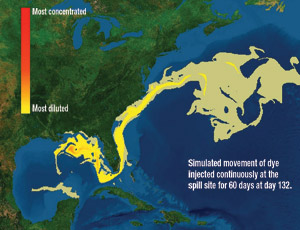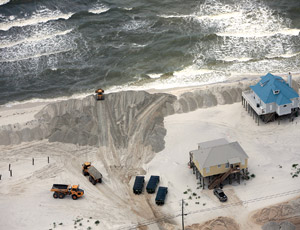As contractors mobilized to berm Louisiana’s shoreline to protect its wetlands from oil gushing out of a ruptured well in the Gulf of Mexico, the nation focused on the plan’s chances for success, the disaster’s economic and environmental consequences, and the future of the region’s offshore oil industry.


BP made a $60-million payment on June 7 so that Louisiana can start the berms. BP is on the hook for the total $360-million estimated cost.
“We understand that the U.S. Coast Guard and the state of Louisiana want this project to proceed with urgency, so we want to ensure funding is immediately available to begin construction,“ says Bob Dudley, BP’s managing director.
The state signed a project management contract with The Shaw Group Inc., Baton Rouge, La., on June 3. By the next day, Shaw had met with dredging contractors and moved two bucket dredges to the first of six project areas, says Charlie Hess, project manager.
Shaw is hustling to devise the sequence and schedule and sign contracts. It has asked dredging industry representatives for a list of all available equipment and prices immediately.
Shaw plans to use an array of equipment and start by building a “training dike.“ Hess describes it as a low ridge on the main berm’s seaward edge. When Shaw begins to pump dredge material, it will fill behind the training dike.
As of June 7, U.S. Coast Guard Adm. Thad Allen, national incident commander, said the spill had hit 120 miles of coastline in four states but said the impacted area is probably greater because oil is going deeper into marshlands. “The effect could be far greater than that,“ he said.
Allen says that, after the well is closed, cleanup will take four to six weeks, but restoration of habitats and the environment will take “years.“
Allen says BP’s June 4 installation of a cap-and-riser on the sheared top of the well is recovering oil at the surface. BP says it captured 14,800 barrels in 24 hours on June 7. It is closing vents gradually around the cap to keep oil pressure from knocking the cap off or forcing oil around the seal between the cap and the blowout preventer that failed on April 20.
BP expects soon to be able to handle up to 20,000 barrels per day at the surface, but more would require bringing another ship or platform to the scene.
Allen says BP has stopped giving estimates of the oil loss because federal authorities will use the figures to assess fines. Allen says a new federal flow-rate technical group will soon provide the figures, although it already says the release may be as much as 25,000 bpd.
Two relief wells scheduled for completion in early August hold the best chance for stopping the flow, says Allen. On June 7, the first relief well was about 8,000 ft below the seafloor, and the second was about 3,000 ft below the seafloor. They are being drilled vertically to about 6,000 ft and then angled toward the bottom of the blown-out well bore.
Dave Rensink, the incoming president of the American Association of Petroleum Geologists, says the second well is there in case the first one fails. He says drilling through the sand and shale can advance only a few hundred feet a day.
Once the wells reach 13,000 ft below the seafloor, drillers will use trial and error to intersect the well bore, as 3D information at that depth is not precise, Rensink says. Drillers probably will require several attempts. They will fill failed holes with drilling cement and then use their coordinates as guides to narrow in on the target, he says.
The federal Minerals Management Service lifted a moratorium on shallow-water drilling on June 8, but government and industry officials are more concerned about a six-month moratorium on deepwater drilling that President Obama insists will stand.
Louisiana Gov. Bobby Jindal (R) predicts the deepwater ban will cost the state 3,000 to 6,000 jobs by June 30 and...

Post a comment to this article
Report Abusive Comment